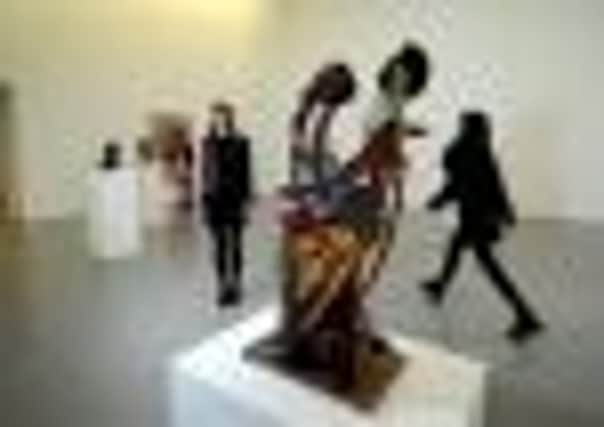Shaping time and sculpture on the eve of war


IT’S sometimes said that the modern world, and in a sense the 20th century itself, only really started in 1918 in the wake of the First World War.
But in the art world, at least, by 1913 modernity was very much alive and the shock of the new was already happening. Cubism and Futurism were already firmly established and this was the year that saw the opening of the Omega Workshops established by Roger Fry and other members of the Bloomsbury Group, Sergei Diaghilev’s The Rite of Spring, which famously sparked a riot in Paris, and the start of Marcel Proust’s Remembrance of Things Past.
Advertisement
Hide AdAdvertisement
Hide AdIt’s also the year around which the latest exhibition at the Henry Moore Institute revolves. The show, 1913 – The Shape of Time, features around 25 works drawn from private and public collections, including pieces from Germany, France and Italy.
The gallery’s curator Jon Wood says this was a significant cultural moment. “There were some incredibly exciting artistic developments that started in Paris and spread out across Europe and by 1913 our critical writing around these developments, around Cubism and Futurism, was pretty well established, so it’s a year in which a lot comes together.”
The other, looming significance is the fact that it’s the year before the start of a war that not only changed the face of Europe, but the world itself. “You have this tremendous promise that is about to get cut short. But I think this year is often seen in terms of painting, in terms of colour theory and the paintings of Sonia and Robert Delaunay, but the sculpture at this time was also quite incredible and this show is about putting sculpture in the foreground and looking at what was happening in the land of sculpture at this time.”
The show has two key strands to it. “In this year there was a lot of talk about the standardisation of time and time itself became a subject matter for sculptors and artists, how they shaped the impact of time within the human bust or between two figures. That’s one theme and the second is that although most of the works in this exhibition originate in 1913, today many of them come to us as later casts. So the Marcel Duchamp work we have dates back to that year but comes to us as a replica made in the sixties,” explains Wood.
Advertisement
Hide AdAdvertisement
Hide Ad“I think a lot of people when they see an art work assume they’re looking at one moment in time, one moment of creativity, but one of the things sculpture has always been able to do and can do is replicate. Henry Moore’s sculpture, for example, was often part of a series and the story of sculpture in general is very much about replication.”
The early part of the 20th century was a period of huge cultural and technological change in Europe. “There is a sense of the modern world, the international discussions around the 24 hour clock, the wireless and technological developments were charging artists’ imaginations and giving them permission to experiment in all kinds of unusual ways and break with earlier traditions.”
But at the same time artists were still working with recognisable forms.
“You still have the full length figure, the portrait bust and still life works, but the artists rupture their meaning and wanted to challenge our expectations.”
Advertisement
Hide AdAdvertisement
Hide AdWood is keen to point out that the exhibition is not an exhaustive study of sculpture from that single year. “It’s not about a zeitgeist moment where everything was wonderful in 1913, it is putting a torchlight on a very interesting and creative moment in European history but it’s about saying that the energies present here carry on into the present.”
The exhibition includes some stellar names from the pantheon of modern art alongside some you probably haven’t heard of.
“If you were to look at a history of 20th-century modern art, it starts, in a sense, at this moment,” says Wood. “Many of the famous players, people like Duchamp, Picasso and Modigliani, are here, but what we’ve also tried to do with this show is something a little bit different and we’ve dug deeper to find some less well known names as well, particularly from Russia and Eastern Europe.
“It’s interesting because 1913 is well known as being the year of the Armory Show and the arrival of modern art in New York, so we’ve looked East at some of the experimental artists that weren’t represented at the Armory Show.”
Advertisement
Hide AdAdvertisement
Hide AdThe end result is that the gallery has created yet another visually impressive, thought-provoking exhibition.
“It’s been carefully selected and although it’s about this one year it’s also about time and it’s about replication. And hopefully people will come here and look back and see what art was like 100 years ago, or that started life a century ago and was remade in the 50s or 60s.
“The idea being that it will encourage people to ask more questions about art from their own time, too.”
1913 – The Shape of Time, Henry Moore Institute, Leeds, to February 17, 2013.
1913: A year in the life of art
Advertisement
Hide AdAdvertisement
Hide AdThe early part of the 20th century saw an explosion of creativity in European art, literature and music with Paris at its epicentre and in 1913 there was a lot going on.
The poet, playwright and art critic Guillaume Apollinaire produces his book The Cubist Painters.
Marcel Proust’s epic novel Remembrance of Things Past begins its publishing life.
Sergei Diaghilev’s avant garde music and choreography for The Rite of Spring ballet causes a near riot when it is first performed at a theatre on the Champs-Elysees.
The Armory Show is credited with introducing modern art to New York.